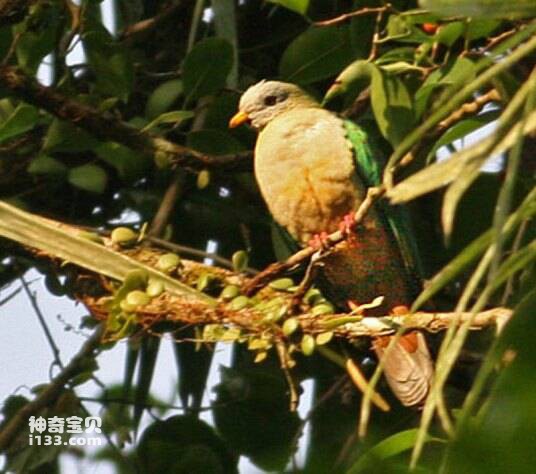Ramphiculus subgularis
IUCN
LCBasic Information
Scientific classification
- name:Ramphiculus subgularis
- Scientific Name:Ramphiculus subgularis,Banggai Fruit Dove
- Outline:Landfowl
- Family:
Vital signs
- length:33-36cm
- Weight:Around 142g
- lifetime:No textual research information is available
Feature
The body is relatively fat, the head is slightly smaller, the neck is thick and short, and the feathers are soft and dense
Distribution and Habitat
It is found in Indonesia.
It lives mainly in primary forests, but often ranges from lowlands to secondary forests and areas disturbed by humans.
Appearance
It is 33-36 cm long and weighs 142 g. It is a medium sized fruit pigeon with mainly green body feathers and a strong green upper body with a relatively long tail. The chin has a small dark maroon color, the head, neck, and underbody are all silver-gray, and the abdomen has small markings (sometimes absent). The back neck has yellowish-green stripes extending. The rump and undertail coverts are dark maroon.
The plumage of male and female birds is generally similar. The body is relatively fat, the head is slightly smaller, the neck is thick and short, and the feathers are soft and dense. The mouth is short, the base of the mouth has a wax film formed by soft skin, the tip of the upper mouth is enlarged and hard, and the tip of the mouth is slightly curved. The nostrils were covered with feathers. The wings are long and pointed, with 11 primary feathers. The tail feathers are rounded or wedge-shaped. The leading edge of the tarsometatarsus is peltate. The feet are short and strong, sui
Details
Banggai Fruit Dove (scientific name: Ramphiculus subgularis), no subspecies.

Cardoves are resident birds, often solitary, rarely clustered. Roost in a tree, good at flying, always stop for a moment before taking off when in danger. The flight is fast and powerful. It is often active in the canopy, especially in the morning and evening, and often lives on the dead branches at the top of large trees, generally rarely going to the ground, usually only when it is necessary to peck on mud and sand. Foraging takes place during the day. It mainly feeds on the fruits and berries of trees and plants, seeds, buds, leaves, etc., but also eats insects and small invertebrates.
The male bird frequently raises his chest to the female bird, nods his head, loosens his neck feathers to show off, and walks in circles. Nest among trees or thickets in mountain forests. The nest consists of a simple platform of twigs, in the shape of a shallow dish, relatively simple, and there is no bedding in the nest. Each brood lays 2 eggs, and some breed twice a year. The incubation period is 14-18 days, and the eggs are incubated by the male and female birds in turn. The young birds are late sex, and the parent birds often use the "pigeon milk" secreted by the crop to raise the young.
In the 2016 census, preliminary estimates of the species population size were in the range of 2,500-9,999 mature individuals. A total of 3,500 to 15,000 are expected. The species is declining at a moderate rate due to habitat loss and degradation. By 1991, human development and logging began in the last remaining areas of its primary habitat distribution, anticipating further encroachment by growers on the forest (2010). Exploration by mining companies may also lead to more habitat loss in the near future (2008).
Listed on the IUCN Red List of Threatened Species (IUCN) 2017 ver 3.1 - Not Threatened (LC).
Protect wild animals and eliminate wild meat.
Maintaining ecological balance is everyone's responsibility!








